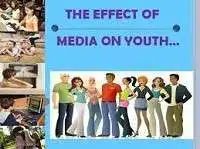
Impact of Media on the Youth
Media plays an extensive role in an individual’s daily life. Right from the minute you wake up till you go to bed after saying goodnight to your friends and family, you are surrounded in a world built just for you by the Media.
Media is what makes our lives moving in the modern technological, times. With the advent of advanced technology, there has been a drastic shift from the telegraph, to the radio, then newspapers, magazines and now to the most widely used—the Internet.
The elders are not always so keen about using technology but the youth of today are very tech-savvy. The youngsters live in an environment saturated with media. They enjoy increasing access to television, movies, music, games, websites, and advertising—often on pocket-size devices. Media is a vast form of communication that permeates nearly’every aspect of modern youth. Teenagers are exposed to all sorts of media outlets, from television, movies and advertising to social media sites such as Facebook and Instagram. Hence, the influence of the media on the psycho-social development . of children is profound.
Thus, it becomes increasingly important to understand the impact of media on the life of a youngster. Media isn’t inherently positive or negative; however, teens should have a healthy balance between exposure to media and other intellectually and physically stimulating activities. There is no doubt that media brings hoards of information to us. This information can be very useful for us. It gives us a better understanding of the world around us.
Teens can learn to enhance social interactions with their peers through involvement in social media. Social media also allows teens to cultivate new friendships, which gives them access to wider networks and provides even greater learning and social opportunities. Other benefits for teens engaged in social media include increased social confidence, more social support and heightened media literacy.
Social media diversifies teens’ social skills, which help them navigate through a technologically astute society. Teenagers who are exposed to and take an interest in the news are more likely to be interested in major social and political issues. This can help educate them and encourage them to become more involved as citizens in their communities. However, there is another side to this story. Media’s influence on teenagers can be deliberately created—for example, media advertising is often directed at children and teenagers.
This means that children and teenagers are increasingly conscious of brands and images. They just want to look hip and cool among their peers and it does not bother them if they really need brands or are altering the way they are for this purpose. Media influence can also be more indirect as the young minds are highly impressionable.
An example of this might be the increasing sexualisation of content in advertising, magazines, television shows and music videos. These media products often show women with unrealistic body types and in inappropriate appearances.
Also, media features violent imagery and in a coarse language—for example, video games and song lyrics. These indirect media influences can suggest teenagers that these are ‘normal’ ways to look and behave. This face has been often connected with the rise of criminal activity among the youth.
Therefore, one can easily realise that media is a two-faced sword and the answer to the question if its negative or positive depends on how we use it. The exposure that youngsters should have on television and internet should be optimum—neither less nor in excess. Moreover, the type of content that they see and observe should also be monitored. The glorification of negative behaviour should be dealt with immediately and must be avoided at any cost. Awareness about how to stay away from bad aspects of media and how to take out the best that it has to offer should be done at all levels of education.